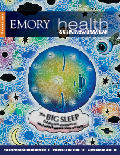Customized care for complex aortic aneurysms

|
Abdominal aortic aneurysms are common—9% of men over 65 have one. And if they rupture, they are lethal, causing a person to die of rapid blood loss within minutes.
The good news is that abdominal aneurysms can be surgically repaired, if found in time. The bad news is that half of patients with these aneurysms are unable to have conventional surgery because they have other conditions that rule it out.
Enter Emory vascular surgeon Joseph Ricotta. He is one of only a handful of surgeons in the United States who are able to offer a custom-made solution to people with complex abdominal aortic aneurysms.
Ricotta fashions a stent graft (a tiny tube of fabric and metal) that is fenestrated and branched, which he customizes based on a patient’s CAT and PET scans. He then inserts the graft into the aorta through arteries in the groin. Holes in the graft line up with the necessary blood vessels to preserve blood flow and shore up the artery without puncturing the aorta.
“The people who benefit from this procedure have no other options and could not survive open aortic surgery,” says Ricotta, who came to Emory from the Mayo Clinic, where he had performed more than 100 of the fenestrated and branched endograft procedures.
People who are candidates for the investigational approach possess large aneurysms that are likely to rupture. They often are too sick from heart, lung, or kidney disease to undergo conventional aortic surgery.
Short- and mid-term results of the fenestrated and branched grafts indicate that they are safe and effective in treating selected patients, with a low incidence of complications. Between 20% and 30% of patients who undergo the traditional open chest and abdominal surgical procedure die within one year, and 10% to 15% will die during or shortly after surgery. Mortality for the new procedure is much lower—at 1% to 2%. Emory is one of only a handful of institutions in the country and the only place in the Southeast that offers the procedure.
Screening remains a vital tool in saving lives lost to aortic aneurysms, and Congress recently recognized its importance by revising the SAAAVE Act (Screen Abdominal Aortic Aneurysms Very Effectively). The new legislation includes ultrasound screening for at-risk Medicare beneficiaries aged 65 to 75 years.
“Screening is crucial because abdominal aortic aneurysms are asymptomatic, silent killers,” Ricotta says. “That’s why early detection with ultrasound is key.”
|
Web Connection: To see a video about the customized treatment of aortic aneurysms, see bit.ly/aorticaneurysms. For more information, call 404-778-7777 or visit emoryhealthcare.org/connecting/healthconnection.html. |
||||


